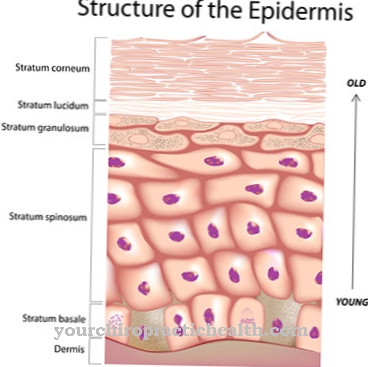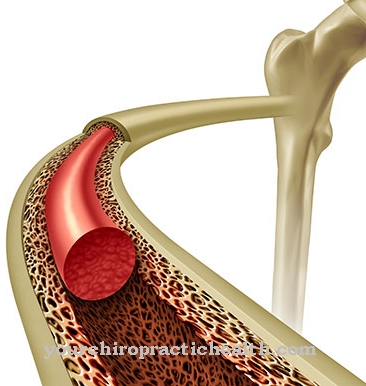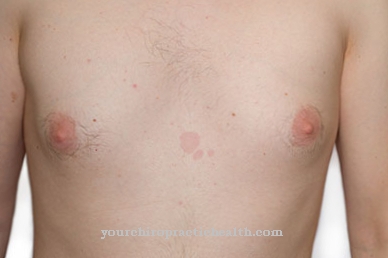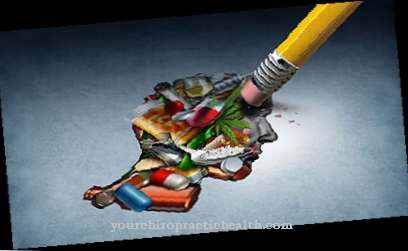At a uremic pruritus it is a chronic itch in dialysis patients. The exact mechanism of its formation is not yet known. Curative therapy is only possible through a kidney transplant.
What is uremic pruritus?
In dialysis patients, chronic itching occurs very often, which is also known as uremic pruritus referred to as. The Latin term is Uremic pruritus. It is believed that around 50 to 90 percent of all dialysis patients have uraemic pruritus. This is not an independent disease, but a symptom.
The itching is difficult to combat and leads to sleep disorders and psychological impairment. It has been observed that, in percentage terms, hemodialysis patients are more pruritic than peritoneal dialysis patients. Nonetheless, both procedures can lead to uremic pruritus. Hemodialysis takes place outside the body.
The blood is channeled out of the body, cleaned through membranes and then returned to the body. Peritoneal dialysis takes place inside the body. The peritoneum acts as a filter membrane.In this procedure, a dialysis solution is filled into the abdominal cavity, which remains there for several hours and absorbs urinary substances from the blood through the biological membrane (peritoneum).
After a few hours this used up solution is exchanged for fresh dialysis solution. In addition to uremic pruritus, almost 100 percent of dialysis patients also suffer from various skin diseases. These skin diseases can also lead to excruciating itching. However, uremic pruritus must be differentiated from other forms of pruritus. It has been found that this particular form of pruritus only occurs in patients on dialysis.
causes
The mechanism by which uremic pruritus develops is not yet fully understood. There have been some attempts to explain this, but it has not yet been verified. With kidney failure, the skin often dries out. Many patients also have anemia. The serum levels of magnesium and aluminum are often elevated. The parathyroid hormone can also be increased. All of these factors cause itching.
Finally, the itching can also be triggered by concomitant diseases of kidney failure. These diseases include diabetes mellitus, hypothyroidism and hepatitis. In some cases, drug intolerance can also be responsible. An increased release of histamine as a cause of the itching is also being discussed. It is known that the concentration of mast cells in the skin is increased in renal insufficiency.
Mast cells have a function for the immune system by releasing histamine. So histamine irritates the nerve endings and thus causes the perception of itching. Furthermore, substance P is also increased in chronic kidney failure. This stimulates the opioid receptors, which can also be felt as itching. However, it is observed that this agonizing pruritus usually develops during or after dialysis. However, it can also occur between dialyses.
Symptoms, ailments & signs
Uremic pruritus is not an independent disease, but only occurs in the context of stages 4 and 5 of kidney failure requiring dialysis. Renal insufficiency in stages 1 to 3 are still largely symptom-free. In addition to agonizing, persistent itching, patients also suffer from the other typical symptoms of stage 4 and 5 kidney failure.
These include pain in the kidney area, brown urine, kidney stones or even inflammation of the renal pelvis. Furthermore, nausea, vomiting, reduced mental performance, loss of appetite, water retention, shortness of breath and, above all, skin changes occur. The skin changes appear in the form of scratches, open wounds or scars and are the result of scratching and the agonizing itching.
Diagnosis & course of disease
The itching can be diagnosed as uremic pruritus if it occurs during, after, or between dialysis treatments. It usually only lasts a few minutes and occurs regularly. The diagnosis of "uremic pruritus" can be made within two weeks if it occurs three times. The physical examination shows scratch marks.
Complications
Uremic pruritus is primarily associated with severe discomfort for those affected. The possible complications are similar to those of stage four and five kidney failure. This can lead to the development of kidney stones or even an inflammation of the kidney pelvis. In addition, there are severe gastrointestinal complaints, water retention and shortness of breath.
In the advanced stage, those affected also suffer from noticeable skin changes, caused by the constant scratching as a result of the excruciating itching. Open wounds, scratch marks and later also scars are typical. Depending on how the underlying disease progresses, uremic pruritus can cause further complications or go without symptoms for the person concerned.
There are usually no major problems with the treatment. However, the urea-containing creams can cause skin irritation and occasionally aggravate itching. Radiation treatment carries the risk of bone disease and changes in tissue structures, which in rare cases can lead to cancer.
Painkillers and anti-inflammatories cause side effects and interactions in some patients, for example stomach pain or sensory disturbances. Allergy sufferers are at risk of anaphylactic shock.
When should you go to the doctor?
In any case, medical treatment must be provided for this disease. It is a very unpleasant complication of dialysis, which can be restricted in many cases. The person affected should therefore consult a doctor as soon as the first signs and symptoms of the disease appear, so that the symptoms do not worsen or other complications arise. An early diagnosis has a positive effect on the further course of the disease. A doctor should be contacted if the person concerned suffers from very severe itching during dialysis.
Difficulty breathing or severe loss of appetite can also indicate this disease. Those affected not infrequently also suffer from vomiting or severe nausea. If these symptoms occur over a longer period of time and do not go away on their own, a doctor must be contacted. If you have this disease, you should contact the doctor who is responsible for the dialysis. However, complete cure can only be achieved with a kidney transplant.
Treatment & Therapy
A curative treatment of uremic pruritus is only possible with a kidney transplant. There are no other healing options for kidney failure requiring dialysis. However, there are some symptomatic treatment options that promise relief from itching. Topical, physical, surgical and systemic treatments are offered.
In topical therapy, creams containing urea are used to ensure that the skin is kept moist. Mild soaps must also be used. Physical therapy, in turn, is phototherapy with UV-B radiation. Irradiation relieves the painful itching. The mechanism of action of the radiation has not yet been clarified.
If the uremic pruritus is caused by an overactive parathyroid gland, surgical removal of the parathyroid corpuscles promises improvement. Finally, systemic treatments with various drugs can be carried out. However, the chances of success are different.
In many cases, the treatment results are also not satisfactory. Gamma-linolenic acid has a certain effectiveness because it inhibits the formation of lymphocytes and the synthesis of lymphokines. This prevents inflammatory reactions.
You can find your medication here
➔ Medicines against itchingprevention
Since uremic pruritus is the result of acute or chronic kidney failure, the prevention of kidney disease must be focused on in order to prevent it. Kidney damage can result from high blood pressure or diabetes, among other things.
Therefore, the prophylaxis of kidney failure and uremic pruritus includes strict weight control, reduction of obesity, plenty of exercise, restriction of table salt consumption, a balanced diet and refraining from smoking and alcohol. The diet should be low in calories and fat. At the same time, it is recommended that you eat plenty of fruit and vegetables.
Aftercare
In the case of uremic pruritus, the follow-up examinations and aftercare treatments generally focus on symptomatic treatment of the itching. Follow-up care can only be limited to relieving or suppressing the itching. The uremic pruritus itself cannot be cured from a medical point of view. There is no corresponding therapeutic treatment concept.
Because uremic pruritus is only a symptom of a kidney dysfunction (e.g. kidney failure). The itching only disappears suddenly once the underlying disease has healed. Only a kidney transplant can help here. Until then, uremic pruritus can only be effectively treated with a combination of several drugs. The task of follow-up care is to continue the medication that has been started clinically and to adapt it to the disease in accordance with the symptoms.
For this purpose, the person concerned must be presented regularly on an outpatient basis. In addition, the affected person must learn during follow-up care to adapt their living conditions to the disease. The itching can also be relieved through numerous self-help measures. It is important to first switch off the trigger factors (trigger of the itching) in the everyday life of the person affected.
Light clothing (preferably made of cotton) should be worn. The water temperature should not exceed 35 degrees Celsius when bathing or showering. To prevent the skin from drying out, it is advisable to set up humidifiers in rooms. In addition, personal hygiene should not be overdone (that is, not too hot, not too often and not too long).
You can do that yourself
Uremic pruritus requires medical treatment. The condition is treated surgically or conservatively, which should lead to a significant improvement in the individual symptoms. Medical treatment can be supported by various self-help measures.
First of all, it is important to strictly adhere to the medical guidelines. In particular, the intake of medication, as it is necessary for systemic treatment, must be carried out exactly as prescribed. Otherwise, serious complications can arise. Sport is also recommended. Gentle physical activity supports recovery just as effectively as rest and protection. The training plan is best worked out with a physical therapist.
The diet, which must be particularly gentle in the case of advanced kidney disease, also requires a detailed analysis by an expert. Patients have to drink a lot and eat a low-fat and low-sugar diet so as not to put additional strain on the kidneys. The patient should keep a complaint journal and note any unusual symptoms. In addition, any side effects of the prescribed antihistamines must be written down and reported to the doctor.
The self-help measures mentioned should be discussed with the doctor. The doctor can name further measures to support the recovery process.



























